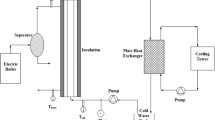Abstract
This work is focused on numerical simulations of natural convection heat transfer in Al2O3-water nanofluids using computational fluid dynamics approach. Fluent v6.3 is used to simulate water based nanofluid considering it as a single phase. Thermo-physical properties of the nanofluids are considered in terms of volume fraction and size of nanoparticles, size of base fluid molecule and temperature. The numerical values of effective thermal conductivity have also been compared with the experimental values available in the literature. The numerical result simulated shows decrease in heat transfer with increase in particle volume fraction. Computed result shows similar trend in increase of Nusselt number with Relayigh number as depicted by experimental results. Streamlines and temperature profiles are plotted to demonstrate the effect.










Similar content being viewed by others
Abbreviations
- A m :
-
Surface area of the fluid particle
- C pf :
-
Specific heat of fluid
- C pp :
-
Specific heat of particle
- g :
-
Acceleration due to gravity
- h :
-
Heat transfer coefficient
- T H :
-
Temperature of hot wall
- T L :
-
Temperature of cold wall
- k eff :
-
Effective thermal conductivity
- k f :
-
Thermal conductivity of the fluid
- k p :
-
Thermal conductivity of nanoparticle
- L :
-
Length of the cylindrical fluid container
- N u :
-
Nusselt number
- Q :
-
Input power
- r p :
-
Radius of fluid particle
- R a :
-
Rayleigh number
- T :
-
Nanofluid temperature
- T ref :
-
Reference temperature (293 K)
- μ f :
-
Viscosity of the base fluid
- μ o :
-
Reference viscosity of water
- ρ f :
-
Density of fluid
- ρ :
-
Density
- ρ p :
-
Density of nanoparticle
- φ :
-
Volume fraction of nanoparticle
- η n :
-
Kinematic viscosity of the nanofluid
- α n :
-
Thermal diffusivity of the nanofluid
References
Lee S, Choi SUS, Li S, Eastman JA (1999) Measuring thermal conductivity of fluids containing oxide nanoparticles. ASME J Heat Transf 121:280–289
Xuan Y, Li Q (2000) Heat transfer enhancement of nanofluids. Int J Heat Fluid Flow 21:58–64
Eastman JA, Choi SUS, Li S, Thompson LJ, Lee S (1997) Enhanced thermal conductivity through the development of nanofluids. In: Komarneni S, Parker JC, Wollenberger HJ (eds) Nanophase and nanocomposite materials II. MRS, Pittsburg, pp 3–11
Eastman JA, Choi SUS, Li S, Yu W, Thompson LJ (2001) Anomalously increased effective thermal conductivities of ethylene glycol-based nano-fluids containing copper nano-particles. Appl Phys Lett 78:718–720
Choi SUS, Zhang ZG, Yu W, Lockwood FE, Grulke EA (2001) Anomalous thermal conductivity enhancement in nano-tube suspensions. Appl Phys Lett 79:2252–2254
Das SK, Putra N, Thiesen P, Roetzel W (2003) Temperature dependence of thermal conductivity enhancement for nanofluids. ASME J Heat Transf 125:567–574
Khanafer K, Vafai K, Lightstone M (2003) Buoyancy driven heat transfer enhancement in a two-dimensional enclosure utilizing nanofluids. Int. J Heat Mass Transf 46:3639–3653
Jang SP, Choi SUS (2004) Free convection in a rectangular cavity (Benard convection) with nanofluids. In: Proceedings of the IMECE, Anaheim, California, USA
Jou RY, Tzeng SC (2006) Numerical research of natural convective heat transfer enhancement filled with nanofluids in rectangular enclosures. Int Commun Heat Mass Transf 33:727–736
Santra AK, Sen S, Chakraborty N (2008) Study of heat transfer augmentation in a differentially heated square cavity using copper–water nanofluid. Int J Thermal Sci 47:1113–1122
Hwang KS, Lee JH, Jang SP (2007) Buoyancy-driven heat transfer of water-based Al2O3 nanofluids in a rectangular cavity. Int J Heat Mass Transf 50:4003–4010
Jafari A, Mousavi SM, Tynjala T, Sarkomaa P (2009) CFD simulation of gravitational sedimentation and clustering effects on heat transfer of a nano-ferrofluid. In: PIERS proceedings, Beijing, China, March 23–27
Ismail AF, Rashmi W, Khalid M (2008) Numerical study on buoyancy driven heat transfer utilizing nanofluids in a rectangular enclosure. In: Proceedings of the UK-Malaysia engineering conference 2008, London, 118–123
Putra N, Roetzal W, Das SK (2003) Natural convection of nanofluids. J Heat Mass Transf 39(8–9):775–784
Maxwell-Garnett JC (1904) Colours in metal glasses and in metallic films. Philos Trans Roy Soc A 203:385–420
Eastman JA, Phillpot SR, Choi US, Keblinski P (2000) Thermal transport in nanofluids. Annu Rev Mater Res 34:219–246
Author information
Authors and Affiliations
Corresponding author
Rights and permissions
About this article
Cite this article
Rashmi, W., Ismail, A.F., Khalid, M. et al. CFD studies on natural convection heat transfer of Al2O3-water nanofluids. Heat Mass Transfer 47, 1301–1310 (2011). https://doi.org/10.1007/s00231-011-0792-x
Received:
Accepted:
Published:
Issue Date:
DOI: https://doi.org/10.1007/s00231-011-0792-x




